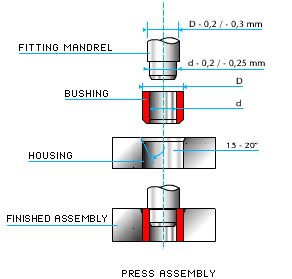Assembly instructions for steel bushings
(PEL®, PEL® BH)
Tolerances:
Interference:

Generally, steel bushings with outside diameter with p6 tolerance, are best installed in housing with H7 tolerance. However, for severe conditions of very high loads and very large diameter… the interference can be increased. Please contact us for additional information.
Clearance:
Generally, steel bushings with inside diameter with H9 tolerance, are best used with a pin with f7 tolerance. However, for particular working conditions (temperature, abrasion…), interference can be increased in order to avoid risks of seizure. Please contact us for additional information.
Fitting:
Generally, steel bushings are preferably assembled by press fitting or with liquid nitrogen. Although other assembly techniques may be used, the HEF Group experts should be consulted prior to use. To facilitate the fitting operation, a short entry chamfer (15–20°) should be machined into the housing and at the end of the mandrel. Lightly grease or oil the external diameter prior to installation.
Greasing:
After bushing installation, fill the cross-hatching or cavities with grease. Assemble the pin in the bushing and complete the greasing with greasing pump (manual pump or automatic system) until the grease is visible outside of the joint. In order to thoroughly distribute the grease in the contact area and to improve the functioning during initial usage, we recommend a regular greasing approximately every 10 hours during the first 50 hours of joint operation to maximize bushing life.
Assembly instructions for H-Liner bushings
Tolerances:
Interference:

Generally, H–Liner bushings are best installed in housings of H7/H8 tolerance. However, for severe conditions of very high loads, very large diameters or high temperatures… the interference can be increased. Please contact us for additional information.
Clearance:
H–Liner bushings are best used with a pin tolerance of h7/h8. However, for particular working conditions (temperature, PV factor…), interference can be increased in order to avoid risks of blocking. Chamfer or radius on the pin are recommended to avoid to damage bushing by the assembly process. Please contact us for additional information.
Fitting:
Generally, H–Liner bushings are preferably assembled by press fitting or with liquid nitrogen. Although other assembly techniques may be used, the HEF Group experts should be consulted prior to use.
To facilitate the fitting operation, a short entry chamfer (15–20°) should be machined into the housing and at the end of the mandrel.
Greasing:
Even if H–Liner are used under dry conditions, an initial greasing could be implemented in order to improve breaking– in period and friction properties.
Greases which contain particles like Copper, Aluminum, MoS2 … and silicon grease have to be avoided.